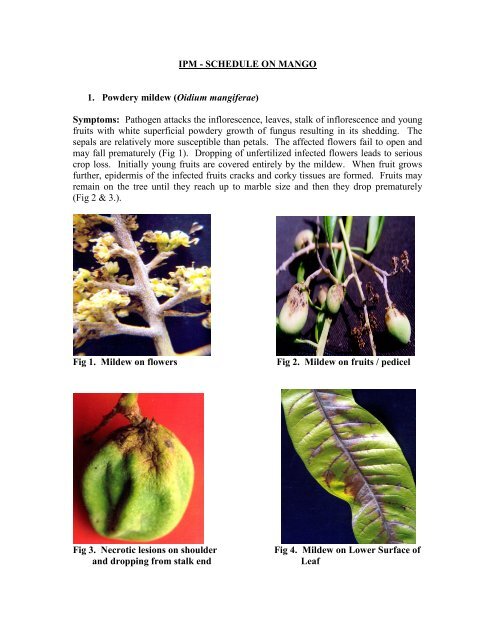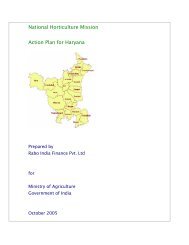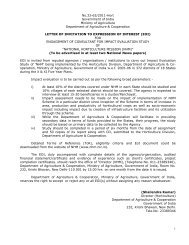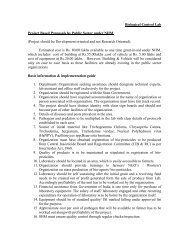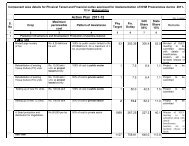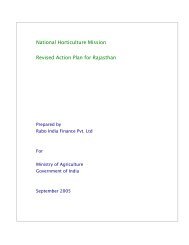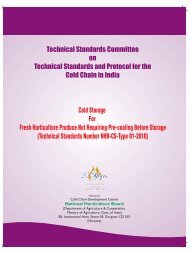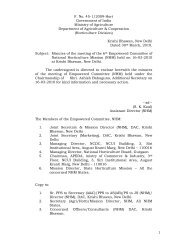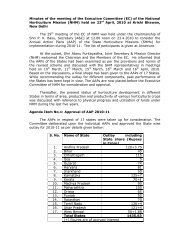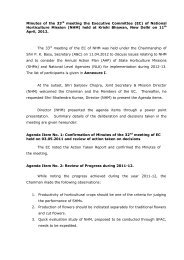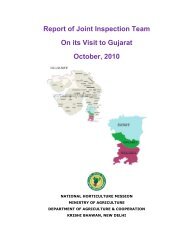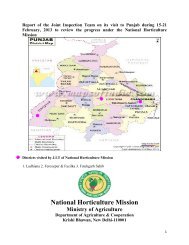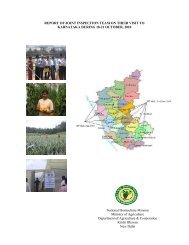IPM - SCHEDULE ON MANGO 1. Powdery mildew (Oidium ...
IPM - SCHEDULE ON MANGO 1. Powdery mildew (Oidium ...
IPM - SCHEDULE ON MANGO 1. Powdery mildew (Oidium ...
You also want an ePaper? Increase the reach of your titles
YUMPU automatically turns print PDFs into web optimized ePapers that Google loves.
<strong>IPM</strong> - <strong>SCHEDULE</strong> <strong>ON</strong> <strong>MANGO</strong><strong>1.</strong> <strong>Powdery</strong> <strong>mildew</strong> (<strong>Oidium</strong> mangiferae)Symptoms: Pathogen attacks the inflorescence, leaves, stalk of inflorescence and youngfruits with white superficial powdery growth of fungus resulting in its shedding. Thesepals are relatively more susceptible than petals. The affected flowers fail to open andmay fall prematurely (Fig 1). Dropping of unfertilized infected flowers leads to seriouscrop loss. Initially young fruits are covered entirely by the <strong>mildew</strong>. When fruit growsfurther, epidermis of the infected fruits cracks and corky tissues are formed. Fruits mayremain on the tree until they reach up to marble size and then they drop prematurely(Fig 2 & 3.).Fig <strong>1.</strong> Mildew on flowersFig 2. Mildew on fruits / pedicelFig 3. Necrotic lesions on shoulderand dropping from stalk endFig 4. Mildew on Lower Surface ofLeaf
Infection is noticed on young leaves, when their colour changes from brown to lightgreen. Young leaves are attacked on both the sides but it is more conspicuous on thegrower surface. Often these patches coalesce and occupy larger areas turning intopurplish brown in colour (Fig. 4). The pathogen is restricted to the area of the central andlateral veins of the infected leaf and often twists, curl and get distorted.Management• Prune diseased leaves and malformed panicles harbouring the pathogen to reduceprimary inoculum load.• Spray wettable sulphur (0.2%) when panicles are 3-4” in size.• Spray dinocap (0.1%) 15-20 days after first spray.• Spray tridemorph (0.1%) 15-20 days after second spray.• Spraying at full bloom needs to be avoided.2. Anthracnose (Colletotrichum gloeosporioides)Symptoms: The pathogen causes leaf spot/leaf blight, wither tip, blossom blight and fruitrots. On leaves characteristic symptoms appear as oval or irregular vinaceous brown todeep brown spots of various sizes scattered all over the leaf surface. Later lesions getblighted and rupture and show, shot hole’ symptom (Fig. 5 & 6)Fig 5. Anthracnose on leafFig 6. Wither tip Phase2
Fig 7. Blossom blight phaseFig. 8. Typical Anthracnose on cultivarHushan-e-araYoung leaves are more prone to attack, than older ones. Petiole, when affected, turnsgrey or black. Disease also produces elongated black necrotic areas on twigs. The tipsof young branches start drying from tip downwards. On blossom small black spotsappear on panicles and open flowers, which gradually enlarge and coalesce to cause deathof flowers. The infected flowers fall-off, leaving more persistent spikes on peduncles(Fig 7). On fruits, it is more common during transit and storage (Fig 8).Management• Diseased leaves, twigs, gall midge infected leaves and fruits, should be collectedand burnt.• Blossom infection can be controlled effectively by spraying of Bavistin (0.1%) at15 days interval.• The foliar infection can be controlled by spraying of copper oxychloride (0.3%)• Pre-harvest sprays of hexaconazole (0.01%) or Carbendazim (0.1%) at 15 daysinterval should be done in such a way that the last spray falls 15 days prior toharvest.• Hot water treatment at 52 0 C for 30 minutes.• Covering the fruits on tree, 15 days prior to harvest with news or brown paperbags.• Use bio control agent viz Streptosporangium pseudovulgare.3
3. Die back (Lasiodiplodia theobromae)Symptoms: The pathogen causing dieback, tip dieback, graft union blight, twig blight,seedling rot, wood stain, stem-end rot, black root rot, fruit rot, dry rot, brown rot ofpanicle etc. The disease is most conspicuous during October November. It ischaracterized by drying back of twigs from top downwards, particularly in older treesfollowed by drying of leaves which gives an appearance of fire scorch (Fig.9 & Fig. 11).Internal browning in wood tissue is observed when it is slit open along with the long axis.Cracks appear on branches and gum exudes before they die out. When graft union ofnursery plant is affected, it usually dies (Fig 10. & 12)Fig 9. Partially Die back infected treeFig 10. Die back on young seedlingFig 1<strong>1.</strong> Old tree showing die backFig 12. Darkening of pith due to die back4
Management• Scion wood selected for propagation should be free from infection• Every care should be taken to prevent introduction of disease in newly plantedorchards.• Any infected portion should immediately be pruned, followed by spraying/pasting of copper oxychloride or pasting with cow dung at the cut ends.• Pruning should be done in such a way that some healthy portion is also removed,to ensure complete eradication of pathogen (3 “below the infection site).• The affected branches should be collected and burnt.4. Sooty mould (Capnodium mangiferae)Symptoms: It is very common wherever honey dew secreting insects, viz. mangohopper, scales, coccids and mealy bugs are found. Black velvety thin membranouscovering on leaves, stems and fruits are its symptoms. In severe cases, trees appear blackand look ugly (Fig 13 & 14).Fig. 13 Sooty Mould on LeavesFig. 14 Sooty Mould on FruitManagement• If honey dew secreting insects are controlled by suitable insecticides, the moulddies out for want of a suitable growth medium. Spraying of monocrotophos(0.05%) at 10-15 days intervals is quite effective.• Spraying of starch @2% is effective.• Spray wettable sulphur +monocrotophos +gum acacia (0.2+0.05+0.3%) or Indianoil formulation No. 1 & 2 (4%) at 15 days interval.• Application of pesticides should cover both sides of leaves.5
5. Phoma blight (Phoma glomerata)Symptoms: The disease is noticed on matured / old leaves only. Fully developed spotsare characterized by dark margin and dull grey necrotic centre. In severe cases, spotscoalesce to form patches, which result in withering and defoliation of infectedleaves (Fig 15 & 16).Fig. 15 Phoma infected leavesFig. 16 Close upManagement• Spray copper oxychloride (0.3%).• Balanced nutrition provides resistance to phoma blight.6. Mango bacterial canker disease (Xanthomonas campestris pv. mangiferaeindicae)Symptoms: The disease is noticed on leaves, leaf stalks, stems, twigs, branches andfruits, initially producing water soaked lesions, later turning into typical canker. Onleaves, water soaked irregular satellite to angular raised lesions measuring 1-4 mm indiameter are formed. These lesions are light yellow in colour, initially with yellow halobut with age enlarge or coalesce to form irregular necrotic cankerous patches with darkbrown colour (Fig 17, 18 & 19).Fig. 17 Bacterial Canker infected LeavesFig. 18 Infection on Leaf Stalks6
On fruits, water-soaked, dark brown to black coloured lesions are observed whichgradually developed into cankerous, raised or flat spots. These spots grow biggerusually up to 1 to 5 mm in diameter, which covers / almost the whole fruit. These spotsoften, burst extruding gummy substances containing highly contagious bacterial cells.(Fig 20 & 21).Fig. 19 Canker on Fig. 20 Cankerous fruit Fig. 21 Black streaksTwigshowing canker in fruitManagement• Regular inspection of orchards, sanitation and seedling certification arerecommended as preventive measures.• Mango stones for raising seedlings (root stock) should always be taken fromhealthy fruits.• Use of wind-breaks helps in reducing brushing/ wounding and thus reduceschance of infection.• Three sprays of Streptocycline (200 ppm) at 10 days intervals reduce fruitinfection.• In severe infection, spraying of Streptocycline (300 ppm) or copper oxychloride(0.3%) is more effective.• An antagonistic phytoplane bacterium, Bacillus coagulans, is found effective.7
7. Mango Malformation [Fusarium subglutinans]Symptoms: Vegetative malformation: Vegetative malformation is pronounced in youngseedlings. The affected seedlings develop vegetative growths which are abnormalgrowth, swollen and have very short internodes (Fig 22 & 23).Floral malformation: The flower buds are transformed into vegetative buds and a largenumber of small leaves and stems, which are characterized by appreciably reducedinternodes and give an appearance of witches’ broom. The flower buds seldom open andremain dull green.Fig. 22 Vegetative MalformationFig 23. Floral MalformationManagement• The floral malformed panicles/ vegetative malformed shoots should be prunedand burnt which reduces the incidence of malformation.• Application of NAA (200 ppm) in the first week of October (Before buddifferentiation stages) followed by deblossoming in the late December or Januaryreduces the incidence of malformation.8
8. Gummosis[Lasiodiplodia theobromae (Pat.) Griffon and Mauble (Synonyms: Botryodiplodiatheobromae Pat.)] [Physalospora rhodina Cooke, perfect stage of Botryodiplodiatheobromae Pat.]Symptoms: The disease is characterized by the presence of profuse oozing of gum on thesurface of the affected wood, bark of the trunk and also on larger braches but morecommon on the cracked branches. In severe cases, droplets of gum trickle down onstem, bark turn dark brown with longitudinal cracks, rots completely and the tree dries upbecause of cracking, rotting and girdling effects (Fig 24).Fig 24. Oozing of gumFig 25. Treated with Copper and cow dung pasteManagement• The diseased bark / portion should be removed or cleaned and pasted withBordeaux paste or copper oxychloride paste or cow dung paste or cow dung paste(Fig 25).• Application of Copper sulphate 500 gm/ tree (depending upon the age of the tree)in soil around the tree trunk is recommended. Gummosis is very less in theorchards receiving regular copper oxychloride sprays for control of leaf spotdiseases.9
9. Scab[Elsinoe mangiferae Bitancourt and Jenkins = anamorph: Sphaceloma mangiferae(Bitancourt and Jenkins)].Symptoms: The scab fungus attack leaves, panicles, blossoms, twigs, bark of stems andmango fruits. Spots are circular, slightly angular, elongated, 2-4 mm in diameter, brownbut during rainy season, lesions differ in size, shape and colour. Symptoms produced bythe disease are very much like those of anthracnose (Fig 26.) On young fruits, theinfection is grey to grayish brown with dark irregular margins. As the fruit attains insize, spots also enlarge and the centre may become covered with the crack fissure andcorky tissues (Fig 27).Fig 26. Scab infected leavesFig 27. Fruit infected with ScabManagement• Frequent sprays of copper oxycholoride (0.3%) to protect new flushes of growthare effective for scab control in nurseries.10. Black Banded[Rhinocladium corticolum Massee, perfect stage Peziotrichum corticolum (Massee)Subramanian]Symptoms: The disease is noticed on the midribs/ veins of the leaves, twigs andbranches as black velvety raise fungal out growth in the form of spots which graduallyincrease in size and encircle the trunk limbs, branches and twigs.The incidence of disease is very low on the main branches. The disease occasionallyspread on the leaves and cause loss. It presents a characteristic and conspicuous black10
anded appearance and thus considered appropriate to name it as ‘Black banded’ diseases(Fig 28 & 29).Fig. 28 Black Banded disease on leafFig. 29 Black Banded disease on twigsManagement• Gunny rubbing on twigs/ branches to remove the black growth.• Spraying of Bordeaux mixture 5:5:50 or copper oxychloride (0.3%).1<strong>1.</strong> Ganoderma root-rot (Ganoderma lucidum)Symptoms: The leaves of affected tree area lusterless and sparse. Diseased tree wiltsand dies. Infected roots are very light in weight and get easily crumbled and powderedwith fingers. The fruiting bodies of the fungus (brackets) appear at the base of the tree inrainy season.Management• Collection of brackets and destruction.• Exposure of roots and drenching with dinocap 2 ml/l and covering with soil andincorporation of green leaves in the tree basin effectively reduce disease.12. Root Rot & Damping off (Rhizoctonia solani kuhn)Symptoms: The disease is characterized by sudden dropping of leaves after theemergence of seedlings from the soil. During prolonged rainy and humid weather,11
infection occurs at / or below the ground level with circular to irregular water soakedpatches. These patches enlarge and ultimately girdle the entire base of the seedlings.(Fig 30 & 31).Fig. 30 Damping off phase of diseaseFig. 31 Root Rot phase of diseaseManagement• Care should be taken that water should not stagnate near the root zone.• Nursery should be raised on elevated beds.• Nursery beds should be fumigated.• Application of Trichoderma in the affected nursery is effective.• During the growing season, Bordeaux mixture (<strong>1.</strong>5%) should be sprayed on theplants and the soil at weekly intervals.13. Red rust(Cephaleuros virescens Kunze)Symptoms: The disease is readily recognized by the presence of the rusty redfructification of the alga on the surface of the leaves, veins, petiole and young twigs andfruit. Initially the spots are greenish grey in colour and velvety in texture which finallyturn into reddish brown in colour. (Fig 32, 33 & 34).12
Fig. 32 Plant infected with Fig. 33 Leaf infection of Fig. 34 Fruit showingRed rust Red rust Symptom of Red rustManagement• If vigour of plant is maintained by balanced nutrients, the disease is less.• Spray Bordeaux mixture (5:5:50) or copper oxychloride (0.3%).• As the disease starts on the onset of rain, it is desired to spray fungicide twiceduring the month of July/ August at 15 days intervals.14. Lichens[Strigula elegans (Free.) Mull Arg.]Symptoms: Lichens are found on full grown trees of mango, mainly on trunks, branchesand twigs in the areas of high humidity, heavy rainfall and poorly managed orchards. Itis seen in the form of whitish, pinkish, superficial patches of different shapes on the maintrunk, branches, leaves and twigs of the trees(Fig)Fig. 35 Mix infection of Red rusts and lichensFig. 36 Lichen on trunk13
Management• Field sanitation and balanced nutrition help in checking the disease.• The lichens can be managed by gunny rubbing followed by spraying the trunk,branches, twigs with commercial caustic soda (<strong>1.</strong>0%)PHYSIOLOGICAL DISORDER15. Black Tip (Chimney disease)Symptoms: Symptoms become visible when the mango fruits attain some size. Smalletiolated area develops near the distal end of the fruit which gradually spreads, turnsnearly black and covers the tip of the fruit completely. The black area remains hard andthe growth of the fruit is checked (Fig 37).Fig. 37 Black Tip on cultivar DushehriManagement• It can be can be minimized by the spray of borax (1%). The first spray should bedone positively at pea stage followed by two more sprays at 15 days interval.• Planting of mango orchard in north-south direction and 5-6 km away from thebrick kilns reduce the incidence.16. Internal Necrosis (Boron deficiency)Symptoms: First, water soaked grayish spots develop on the lower side of the fruit.Late, the spots enlarge and develop into dark brown necrotic area. The internal tissuestarts disintegrating. The pericarp and mesocarp is disintegrated exposing the flesh.Yellow coloured droplets also come out and such affected fruits drop easily (Fig. 38).14
Fig. 38 Internal Necrosis onHanging fruitsClose up of affected fruitsManagement• Foliar spay of borax (1%) at pea stage followed by two more sprays at 15 daysinterval.• Application of 250 gm. boron per tree (10-15 year old) around the tree basin.17. Fruit Clustering (Jhumka)Symptoms: This abnormality is characterized by formation of several fruit lets at the tipof panicle. The fruitlets are darker green in colour and their shape is slightly curved thanthe normal fruits. These fruits generally hang for more time compared to some normalfruits, which subsequently drop due to other fruit drop reasons. However these fruitletsdo not grow more and later drop. The fruits do not have formation of seeds (Fig. 39)Fig. 39 Clustering (Jhumka) in Dushehri15
Management• During flower opening stage spray of insecticides and fungicides should beavoided.• Population of pollinators should be kept more during flowering season.• Pollinizing cultivars should be planted in the orchard.18. Woody Stem gall (Cause not known)Symptoms: Woody galls of 10-15 inches diameter are formed on limbs and branches.The galls are abundant on CVS. Chinnasuvarnarekha, Langra and moderate in Neelam(Fig 40 & 41).Fig. 40 Large woody galls on branchesFig. 41 Breaking of tree near gallsManagement• Remedy lies in removal of galls using saw and applying Bordeaux paste to cutsurface.19. Red nose / soft nose (Cause not known)Symptoms: The malady is severe in late maturing Neelam and Mallika varietiesparticularly in delayed harvest leading to substantial loss. The fruits with red nose areunfit for export. Numerous red nosed fruits are seen on tree during fag end of summerwith onset of showers. Red nose gradually becomes soft and rot (Fig. 42).16
Management• Timely harvesting of fruit.• Proper nutrition to the plant.Fig. 42 Fruits affected with Red nose20. Fruit tumors (Cause not known)Symptoms: Tumors of pea to marble size develop on fruit and are very ugly to look at.The stylar end part is much affected while stem end is practically free from tumors(Fig 43).Fig. 43 Fruit showing tumors17
Management• Removal of affected fruits from the tree and buried in the soil.NUTRITI<strong>ON</strong>AL DISORDERS2<strong>1.</strong> Potassium deficiencySymptoms: Scorching of leaf margins is the characteristic symptom of potassiumdeficiency. Scorching starts from tip downwards. Fruit quality is reduced. Trees withpotassium deficiency are easily prone to pest and disease attack (Fig 44).Fig 44. Scorched Leaf MarginManagement• Application of 1 kg muriate of potash or sulphate of potash along with 2 kg ureaand 6 kg super phosphate during July-August in the basin could rectify potassiumdeficiency.• Dropped leaves should also be incorporated along with manures to enrich the soilhealth and fertility.18
22. Zinc deficiencySymptoms: The leaves become small and narrow with leaf margins bent upward ordownward. Inter nodal length is reduced drastically and the twig with crowded leavesgives rosette appearance. Pale inferential areas and green veins are typical of zincdeficient leaves. The tree with zinc hunger does not grow well and the yield, size andquality of the fruit are reduced. Small plants with severe zinc deficiency may die. Zincdeficiency is conspicuously seen in alkaline, saline and sandy soils (Fig 45).Fig. 45 Deficiency Symptoms of ZincManagement• Zinc deficiency can be rectified by spraying of zinc sulphate 5 g +10g urea /1water twice at 15 days interval.23. Iron deficiencySymptoms: The leaves loose green colour and turn white and is called “Bleaching”.The size of the leaf is reduced. In severe cases of iron deficiency, the leaves dry from tipdownwards. The deficiency is common in soils with high calcium content. Hence, theeffect is known as “calcium induced iron chlorosis” (Fig 46).Fig. 46 Iron Deficiency19
Management• Two sprays at fortnight interval with ferrous sulphate 2.5 g per liter.24. Boron deficiencySymptoms: Cracking of fruit is the characteristic symptom of boron deficiency.Lusterless leathery leaves with thickened veins are the other associated symptoms.Brown areas in yellow fruit pulp are conspicuous (Refer Fig 38.)Management• Application of 250gm boron per tree (10-15 year old) with recommended dose ofmanures during July-August.25. Salt injury / ToxicitySymptoms: The leaves are scorched due to excess salt in soil or irrigation water. Theleaves lose their natural colour and turn to bronze colour. Tip burning is also seen insevere cases of salt injury (Fig).Fig. 47 Salt injury symptoms in leavesManagement:• Raise Diancha as green manure crop with onset of monsoon in the inter-spaces ofthe orchard during tree bearing years and remove.• Farm yard manure and compost should be applied adequately every year.• Gypsum filled gunny bag if kept in flowing irrigation water will reduce salt effect.20
26. Copper deficiencySymptoms: Copper deficiency symptoms frequently develop on young trees whichgenerally occur due to heavy nitrogenous fertilization. It may also be accompanied byZinc deficiency symptoms. The appearance of weak terminal shoots followed bydefoliation and die back of branches, on the top of long drooping or shaped branches ofthe proceeding cycle of growth usually makes evident that copper is needed (Fig 48)Fig. 48 Copper Deficit Mango PlantManagement• Application / spraying of Copper (250 g/ 10 years tree) or Copper oxychloride(0.3%) at monthly interval.1NSECT PEST27. Hopper (Idioscopus clypealis, I.nitidulus and Amritodus atkinsoni)Symptoms: The wedges shaped Nymphs and adult insects puncture and suck sap oftender parts, reducing vigour of plants and particularly destroying the inflorescence andcausing fruit drop. Heavy puncturing and continuous draining of sap causes curling anddrying of infested tissue. They also damage the crop by excreting a sweet stickysubstance facilitates the development of sooty mould (Fig 49 & 50).21
Fig 49. Hoppers damaging inflorescenceFig 50. Fruit drop by hoppersManagement• Avoid dense plantings, prune overcrowded overlapping branches after rainyseason.• Orchards should be kept clean by regular ploughing and removal of weeds.• Conservation of bio control agents like predator, Mallada boninensis, Chrysopalacciperda, egg parasite, Polynema spp. Gonatocerus sp. Tetrastichus sp. andfungus, Verticillium lecanii.• Spraying of 0.2% Nimbicidin or Azadirachtin 3000 ppm@2m/l at initial stage ofhopper population.• Spray Lambda cyhalothrin 5% EC@ 0.5 ml or imidacloprid 200 SL @ 0.25 ml/lor monocrotophos (0.05%). First spray should be done at early stage of panicleformation if hopper population, is more than 5-10 panicle, second spray at fulllength stage of panicle and the third spray after fruit setting (at pea size).• Chemical spray is to be minimized and should be need based.• A rational rotation of insecticide is desirable to counteract the tendency of pest todevelop field resistance.28. Mealy bug (Drosicha mangiferae)Symptoms: The adult bugs are covered with whitish powder and colonize between barkof tree trunk, young shoots and panicles (Fig51). The nymphs’ ascent the trees and settleon inflorescence causing flower drop, affecting fruit set. They also excrete honey dew,a sticky substance, which facilitates development of sooty mould. (Fig. 52).22
Fig 5<strong>1.</strong> Shoot infested with Mealy bugFig 52. Fruits infected with Mealy bugFig 53. Alkathene banding on tree trunk to check migrationFig 54. Coccinellid predators of mealy bug23
Management• Flooding of orchard with water in the month of October kill the eggs.• Ploughing of orchard in November.• Raking of soil around tree trunk to expose the eggs to natural enemies and sun,removal of weeds and releasing 10-15 grubs and mixing with chlorpyriphos dust<strong>1.</strong>5% @250 g/ tree during January.• After mud plastering, banding of tree trunk with alkathene (400 gauge g), 25 cmwide sheets should be fastened to the free trunk with the help of sutli, 30 cmabove ground level and application of Beauveria bassiana product (2g/litre) or5% NSKE in last week of January around tree trunk (Fig 53).• Conservation of bio control agents, Beauveria bassiana, predators, Menochilussexmaculatus, Rodolia fumida and Sumnius renardi.• Releasing 10-15 grubs of cocinellid predator, C. montrozieri per tree (Fig 54).• If nymphs ascended on tree spray Monocrotophos or Dimethoate (0.04%)29. Inflorescence / leaf/ twig midge (Erosomyia indica), Dasineura, amraramanjarae,Procystiphovra mangiferae and Procontarinia, matteriana)Symptoms: The larvae tunnel the axis of inflorescence and destroy it completely.Damage by E. indica causes bending and drying of the inflorescenes. Second attacksstarts at fruit setting as young maggots bore into these tender fruits which slowly turnyellow and finally drop. Third attack is on tender ‘new leaves encircling inflorescence.The most damaging one is first attack in which the entire inflorescence is destroyed. Theinflorescence shows stunted growth and its axis bends, at the entrance point of larva(Fig 55 & 56).Fig 55 Panicle damaged by midgeFig. 56. Twig damaged by midge24
Management• Deep plughing of orchard in October- November to expose pupae and diapausinglarvae to sun’s heat which kills them.• Monitoring of larval population on white paper and apply control measures basedon population.• Spray monocrotophos (0.04%) or dimethoate (0.05%) at bud burst stage.30. Fruit flies (Bactrocera dorsalis, B. correctus and B. zonatus)Symptoms: The female punctures outer wall of mature fruits with the help of its pointedovipositor and insert eggs in small clusters inside mesocarp of mature fruits. On hatching,the maggots feed on fruit pulp and the infested fruits start rotting due to further secondaryinfection (Figs. 57, 58, 59 & 60).Fig. 57 Adult fruit fly Fig 58 traped flies Fig 59 Maggots in pulp Fig 60. Infested fruitManagement• Prior to harvest (30-40 days) collect and disposed off infested and fallen fruits toprevent further, multiplication and carry over of population.• Ploughing of orchard during November-December to expose pupae to sun’s heatwhich kills them.• Hanging of methyl eugenol wooden block traps soaked in ethanol, methyl eugenoland malathion (6:4:1) during fruiting period from April to August @10 traps/ hatie them tightly of 3-5 feet above ground level.• To control adult flies during severe infestation placing poison bait viz Proteinhydrolysate +malathion 50 ml +200 ml molasses in 2 litres of water be sprayedadding an additional 18 liters of water to bait poison. Commencing at preoviposition period and repeat at 15 days interval. Addition of 10 ml methyleugenol in place of molasses is also recommended.• Hot water treatment of fruit at 48 +_ 1 0 C for 60 min.25
• Three weeks before harvesting, spray Deltamethrin 2.8 EC @ 0.5 ml/l +Azadiractin (3000 ppm) or 2 ml/l.• Irradiation of fruits0.25-0.75 KGY to control fruit fly.• If infestation is heavy, bait splash on the trunk only, once or twice at weeklyinterval is recommended. To prepare bait splash, mix 100 gm of jaggery in onelitre of water and add 1 ml of Deltamethrin by using an old broom.• Managing fruit flies also reduces anthrcnose disease and prevents late fruit fall.3<strong>1.</strong> Leaf webber (Orthaga euadrusalis)Symptoms: Initially caterpillars feed on leaf surface gregariously by scrapping/Laterthey make web of tender shoots and leaves together and feed within. Several caterpillarsmay be found in a single webbed up cluster of leaves (Figs. 61, 62, 63 & 64).Fig 6<strong>1.</strong> Webber infested plantFig 62. Close up of web with caterpillarsFig 63. Infection of Aspergillus flavusFig 64. Adult fly, pupae and caterpillarof webber (Orthaga Sp.)26
Management• Pruning of overcrowded and overlapping branches.• Mechanical removal of infested webs by leaf web removing device and burningthem.• Ploughing of orchard done earlier for mealy bug control checks its population.• Two to three sprays commencing from last week of July with monocrotophos(0.05%) or quinalphos (0.05%). This spay will also take care of mango psylla(Apsylla cistellata).• The use of same chemical for every spray should be avoided.32. Shoot gall psylla (Apsylla cistellata)Symptoms: Nymphs emerge during August September and suck cell sap from adjacentbuds. As a result of feeding, buds develop into hard conical green galls (Fig 65.). Thegalls are usually seen during September-October. Consequently there is no flowering andfruit setting. Nymphs pass winter inside the galls (Fig 66).Fig 65. Infestation of shoot gall psyllaFig 66. Nymphs of Apsylla cistellataManagement• Galls with nymphs should be collected and destroyed.• Spray monocrotophos (0.5%) or quinalphos (0.05%) at fortnightly intervalstarting from August.• Spray 2, 4-D (150 ppm, i, e 150 mg/liter of water) during October which opensthe galls and nymphs come out and are killed with cold.• New mango orchard in humid region need to be discouraged.27
33. Stem-borer (Batocera rufomaculata)Symptoms: The damage is caused by grubs either to roots or stems. The grubs afterhatching from eggs first feed on bark and make irregular cavities. It makes tunnelswhich may either be in boring upward, resulting in drying of branches (Fig.).Fig 67. Infestation of borer on tree trunkManagement• Keep orchard clean and healthy.• Cut and destroy affected branches with grubs and pupae.• Clean hole and insert cotton wool soaked in emulsion of monocrotophos (0.05%)or kerosene or petrol in each hole and plug them with mud.• Use of green muscardine fungi, Metarhizium anisopliae or Beauveria bassianna.34. Shoot-borer (Chlumetia transversa)Symptoms: Larvae bore into young tender leaves during August and freshly hatchedcaterpillar bore into mid rib. After a couple of days, they bore into tender shoots near thegrowing point tunneling downward, throwing their excreta resulting in dropping of leavesand wilting of terminal shoots (Fig.68)28
Fig. 68 Infestation of shoot borer on young leavesManagement• Attacked shoots should be clipped off and destroyed.• Spray monocrotophos or quinalphos (0.05%) at fortnightly interval from thecommencement of new flush.35. Bark-eating caterpillar (Inderbella quadrinotata)Symptoms: The caterpillar spins brown zig-zag ribbon-like silken web on tree whichconsists of their excreta and wood particles. Larvae also make shelter tunnels insidewhere they rest.Management• Keep orchard clean and healthy.• Clean hole and put emulsion of monocrotophos (0.05%) in each hole and plugthem with mud.• Drench stem thoroughly with moncrotophos (0.05%) when incidence is high.36. Scale (Chloropulvinaria polygonata, Aspidiotus destructor)Symptoms: The nymphs and adult scale suck the sap of leaves and other tender partsreducing vigor of plants. They also excrete honeydew which helps in the development ofsooty mould on leaves and other tender parts (Fig 69.)Fig. 69 Scale infested leaves and twigsFig. 69 Scale infested leaves and twigs29
Management• Prune heavily infested plant parts to open the tree canopy and destroy’ themimmediately.• Spray monocrotophos 2 times (0.04%) or dimethoate (0.06%) at 21 days interval.• Removal of attendant ants may permit natural enemies to control the insect.37. Stone weevil (Sternochetus mangiferae)Symptoms: Adult weevils (5-8 mm) are stout and dark brown, grubs are white leglessand stumpy Eggs are laid singly on the pericarp of tender marble sized fruits. Onhatching grubs bore through the pulp, feed on seed coat and later damage the cotyledons.Pupation is inside the seed (Fig. 70).Fig. 70 Mango infested with Stone WeevilManagementCultural:• Collection and destruction of infested and fallen fruits at weekly interval tillharvest fruit.• Ploughing of orchard after harvest to expose hibernating adults, reduce,infestation levels.• Destroy all left over seeds in the orchard and also in the processing industries.• Spraying Dimethoate (0.1%) twice at 15 days interval when fruits are of marblesize.30
Chemical:• Spray main trunk, primary branches and junction of branches prior to flowing(November, December) with monocrotophos @ 2.5 ml to control beetles hiding inthe bark.• Spray Acephate 75 SP @ <strong>1.</strong>5 g/l when fruits are of lime size (2.5-4 cm diameter)followed by Deltamethrin 2.8 EC @ 1ml/l after two or three weeks.• Vapour heat treatment of fruits.• Irradiation of fruits with 0.25-0.75 KGY to control stone weevil.Biological:• Parasitoids are unknown on stone weevil. The natural enemies recorded onS. gravis include a mite Rhizoglyphus sp, ants (Camponatus sp., Monomorium sp.and oecophylla smaragdina) and fungus Aspergillus sp, Beauveria bassiana wasfound to be pathogenic on mango weevil.38. Thrips: (Coliothrips indicus, Rhipiphorothris cruentatus, Scirtothrips dorsalis)Symptoms: Nymphs and adults lacerate the tissues and suck the oozing cell sap. C.indicus and R. cruentatus feed on leaves and S. dorsalis on in florescence, and youngfruits. Leaf feeding species feed on mesophyll near leaf tips. Affected leaves showsilvery sheen and bear small spots of faecal matter (Fig 71).Fig 7<strong>1.</strong> Thrips infested leavesManagement• If the infestation is severe, can be controlled by either dimethoate (0.<strong>1.</strong>5%) orMonocrotophos (0.1%)39. Tea –Mosquito bug: (Helopeltis antonii)Symptoms: Major pest of cashew, occasionally damages mango and other fruit crops.Adult is a reddish brown bug with black head, red thorax, and black and white abdomen.Eggs are inserted into epidermis of tender shoots and axis of inflorescence. Adult andnymphs feed on petioles, tender shoots and leaf veins causing necrotic lesions.Management• Spray Dimethoate (0.05) or quinalphos (25 EC) 2 ml/ liter.31
40. Fruit borer: (Deanolis albizonalis)Symptoms: A major pest in Orissa, West Bengal and Coastal Andhra Pradesh. Pest isactive from January to May Adults lay eggs on fruits. After hatching larvae bore intofruits. Fully grown caterpillars (25 mm) have red bands on body alternating with whitebands caterpillars bore into the fruit at the bottom (beak region) and feed inside reachingKernels. Entrance hole is plugged with excreta. Affected fruits rot and fall prematurely(Fig 72).Fig. 72 Fruit borer on mangoManagement• Collection of fruits and dead wood after fruit harvest.• Destroy all fallen fruits.• Spray Monocrotophos <strong>1.</strong>5 ml/l at marble size onwards and repeat withDeltamethrin 28 EC @ 1ml/l after two weeks in case of heavy infection• No spray should be given in fortnight before harvest.4<strong>1.</strong> Leaf miner: (Acrocercops syngramma)Symptoms: Tiny caterpillars mine under the dorsal epidemics of tender leaves and feedwithin; as a result grayish white blisters appear on leaves (Fig 73).Fig. 73 Leaves miner infestation32
Management• Clipped off destroy the affected shoots.• Spray quinalphos (0.05%) or monocrotophos (0.5%) from the emergence of newflush.42. Red tree ant (Oecophylla smaragdina)Symptoms: The ants web and stitch together a few leaves, usually at the top of thebranches and build their nests. The ants are carnivorous and prey upon small insects.However, indirect damage is caused by protecting insects like aphids and scales, whichexcrete honey dew (Fig. 74).Fig. 74 Red tree antsManagement• Nests should be removed and destroyed mechanically by web cutting device.• Spraying any contact insecticides, Dimethoate <strong>1.</strong>5 ml/l after disturbing the nest.43. Inflorescene caterpillars [Eucrostus sp. (Geometridae); Argyroploce aprobola /Meyrick (Eucosmidae); Euproctis fraterna Moore (Lymantriidae)].Symptoms: The caterpillars attack inflorescence and if not controlled cause heavy lossthrough reduced fruit bearing.Management• For efficient management spray Monocrotophos 1ml/l at early panicle emergence.33
44. Termites (Odontotermes sp.)Symptoms: Termites are white in colour, shy to light and remain underground. Theyfeed on root or move upward making the tunnels. They construct mud galleries on treetrunk and under the protection of these galleries; they feed on the bark of the trunks(Fig 75.).Fig 75. Termitorium along with mango treeManagement• Remove the mud galleris on trunk and swab or spray the trunk with Malathion(<strong>1.</strong>5 ml/l).• After two month, drench the soil at the base of the tree with monocrotophos(1ml/l).PEST M<strong>ON</strong>ITORINGSurvey: To monitor the initial development of pest and disease in the endemic areassurvey is prerequisite. Therefore, for field scouting farmers should be mobilized toobserve the pest and disease occurrence at the intervals as stipulated under differentdevelopment stages. The plant protection measures are required to be taken only whenbio control potential does not show promise and pest and disease incidences showsincreasing trend.Field Scouting: Field scouting for pests/disease and bio control fauna/flora by extensionagencies and farmers once in a fortnight should be undertaken to assessincreasing/decreasing trend in the pest/disease incidence and availability of bio controlpotential. This should be done soon after the appearance of new flush after the fall of oldleaves as such stage of the crop having succulent tissues in valuable to attack by pests and34
diseases. The state Departments of Horticulture should make all possible efforts by usingdifferent media, mode and publicity to inform the farmers for field scouting in thespecific crop area having indication of pest and disease build up.Pest Monitoring through Traps:<strong>1.</strong> Through yellow sticky traps: Setup yellow fast coloured sticky traps formonitoring sucking pests one trap/5 trees. Locally available empty yellowPalmolive-tins coated with grease/ Vaseline/castor oil on outer surface may alsobe used.2. Sex pheromone traps: These traps are very useful tool in monitoring and controlof population of fruit fly. Hanging of traps containing 100 ml of water emulsionof methyl euginol (0.1%) + malathion (0.1%) during fruiting season (April-July)is very effective for control of fruit fly. Ten traps per hectare of orchard givessatisfactory control. Traps can be fixed during morning hours.<strong>IPM</strong> STRATEGIESCultural Practices:<strong>1.</strong> Deep plouging of orchard immediately after harvest to expose eggs and pupae ofmealy bug, inflorescence midge and fruit fly.2. Heavy irrigation of orchard in October also helps in destruction of eggs of mealybug, diapause pupae of midge and fruit fly.3. Avoid dense planting, keep orchard clean by regular ploughing, removal or weedsand prune the over crowded and overlapping branches in December for control ofhoppers.4. Raking of soil around the tree trunks and mixing with methyl parathion 2% dust@ 250 g per tree for controlling early instars nymphs of mealy bugs in t he monthof November-December.5. Collection and destruction of stone weevil infested fallen fruits and stones help inreduction and carry over of infestation.Mechanical Control<strong>1.</strong> After mud plastering 25 cm wide, 400 gauge alkathene (Polythene) sheet shouldbe fastened to the tree \trunk with the help of sutili, about 30 cm above the groundlevel to prevent migration of freshly hatched first instar nymphs of mealy bugs inthe month of November-December.2. Early harvesting of mature fruits to avoid fruitfly infestation, collection anddestruction of fruit fly infested fruits.3. Removal of webs made by leaf webber by leaf removing device and burning themin August to September to control leaf webber.4. Pruning of overcrowded and overlapping branches for control of leaf webberdried portion and pasting of copper oxychloride for control of dieback disease.5. Diseased foliage / twig infected with anthracnose disease should be pruned duringthese months.35
6. Removal of powdery <strong>mildew</strong> infected leaves and malformed panicles in April.Biological ControlA large number of parasites, predator and pathogens are very active against pests ofmango in the fields. These are Rodolia fumida, Suminus renardi, Coccinellids,Beauveria bassiana, Verticillium lacani, Mallada boninensis, Chrysopa spp.,Tertrastichus spp., Trichoderma spp., Gonatocerus spp, Podynema spp., Platygaster sp,Eupulmus sp., Systasis dasynearue, Micronimus timidis, Baccha pulchrifrons, etc. whichpay a significant role in population suppression of various insect pests and diseases.These should be conserved in the field.Chemical ControlDisease and pest wise details are given in the text.SOME USEFUL TIPS IN PEST MANGEMENT• Always use protective clothing while spraying.• Avoid spraying insecticides repeatedly. Alternate them with botanicals, whereverpossible to prevent development of resistance and pest resurgence.• Add 0.5 ml of any sticking agent to the spray solution.• Oil should be made into an emulsion before spray by shaking thoroughly in abottle before dilution and sprayed immediately without any delay.• Botanicals may cause phytoxicity when the temperature is more than 32 0 C inpolyhouse. Hence it should be done with caution and only after pre-checking. Itis always better to spray botanicals in the evening.• After spraying any insecticide keep appropriate waiting period before harvestingfruits.• Preparation of neem seed powder extract 4%: Soak 4 kg of pulverized neemseed powder in 20 litres of water overnight or 12 ha. Thereafter, filter through afine cloth or double layered nylon net and make to 100 litres and spray. Onehectare of the crop requires 1000 litres of spray fluid and 40 kg of neem seedpowder.• Preparation of oil emulsion for spray: When oil is used either along or mixedwith insecticides, the spray fluid should be made into an emulsion. Take requiredquantity of oil in a plastic bottle, add sticker and required quantity of insecticide(if oil has to be mixed with insecticide), double the quantity of oil, shakethoroughly, transfer to spray tank, dilute with required water and sprayimmediately.36
Calender of <strong>IPM</strong> ActivitiesMonths Target pest <strong>IPM</strong> activitiesSeptember Leaf webber • Removal of webs by leaf web removingdevice and burning them.• Pruning of over crowded andoverlapping branchesOctoberNovemberEggs of mealy bug,pupae of midge andfruit fly, die-back,anthracnose, phomablightMealy bugs, die-backand anthracnose,phoma blight• Flooding of orchards• Pruning of infected and dried branches,10 cm below the dried portion andpasting of copper oxychloride• Spray of 0.3% copper oxychloride(g/L) after pruning.• Removal of diseased foliage / twigsinfected with anthracnose (twig blightstage)• Deep ploughing of orchards forexposing eggs and pupae of insects.• Removal of weeds in orchards whichharbour insects and diseases.• Spraying of copper oxychloride(3 g/ L ) for die back.December Mealy bug • Fastening of alkathene sheets of 400gauge thickness, 25 cm wide around thebase of tree.• Raking of soil around the tree trunk andmixing with neem.January Inflorescence midge,mealy bug, powdery• Cleaning the alkathene bands at regularinterval.<strong>mildew</strong>• Spray of quinalphos @ 0.05% or somesafer insecticide at bud burst stage.• Removal of weeds and infected youngleaves for powdery <strong>mildew</strong>.February Hopper • Spraying with neem seed kernel extractMarchAprilHopper, powdery<strong>mildew</strong>Hopper, powdery<strong>mildew</strong>(5%) at bud burst stage for hoppers• Spraying with quinalphos (0.05%)• Spraying with sulphur @ 2 g/L.• Second spraying of wettable sulphur @2 g/ L after fruit setting.• Removal of powdery <strong>mildew</strong> infectedleaves and malformed panicles.May Fruit fly, sooty mould • Hanging of methyl eugenol traps(0.1%) + malathion (0.1%)June Fruit fly, anthracnose, • Continuation of methyl eugenol traps37
acterial canker (0.1%) + malathion (0.1%).JulyAugustScale insect, stemborer, red rustShoot gall psylla, leafwebber, red rust,anthracnose, dampingoff (nursery)• Early harvesting of mature fruits toavoid fruit fly infestation andanthracnose.• Collection and destruction of fruit flyinfested fruits.• Second spray of streptocyclin @ 200mg/ L for bacterial canker.• Timely picking of fruits• Spraying of quinalphos @ 0.04% ordimethoate 30 EC @ 0.06% for scaleinsects.• Cutting of stem borer affectedbranches.• Spraying of copper oxychloride (COC)@ 0.3% for red rust and anthracnose.• Spraying of quinalphos @ 0.05%• Removal of leaf webber affectedbranches.• Spraying of copper oxychloride (COC)for red rust and anthracnose.• Proper drainage in nursery.• Sanitation and removal of weeds fromorchard.Environmental Factors Favourable for the Key PestsPestFactorsHoppersShade and high humidity with moderately hightemperature i.,e in February-April and July.Mealy bugLow temperature prevailing during November to MarchInflorescence midge Moderate to high temperature with low humidityprevailing during Jan-March.Fruit flyHigh temperature coupled with high humidity prevailingduring May-July months.Leaf webberHigh temperature with high humidity prevailing duringJune-November.Stem borerModerate temperature and moderate humidity prevailingduring September-OctoberShoot gall psylla Moderate temperature with intermittent high humidityduring August-SeptemberScale insectsHigh temperature and high humidity during July-Augustenhances its infestation38
Stone weevil<strong>Powdery</strong> <strong>mildew</strong>AnthracnoseSooty mold (blotch)Bacterial cankerHigh humidity in coastal areas enhances its infestationCloudy weather, heavy morning mist and increasedhumidity are highly favourable for disease development.Optimum temperature of 25 0 C and favourable moistureconditions.High humidity and presence of sugary substancesThe disease spreads rapidly during rains and is severeduring July-August, the atmospheric temperature 28-30 0C coupled with above 80% humidity are congenial for itsmultiplication.PROTOCOL FOR POST HARVEST MANAGEMENT OF <strong>MANGO</strong>India is the single largest producer of choicest varieties of mangoes in the world.Despite the fact that the country produces quality fruits, approximately 25-30 per cent oftotal produce goes as waste due to improper handling and storage practices. Because ofthis, India’s export share in the world trade is less than 0.4%. It not only makes themango cultivation unattractive but also adversely influences the demand andacceptability.Remarkable improvements have been made in the recent years in post harvesthandling and storage of mangoes. It is important that mango growers adopt theseimproved technologies not only to prevent the enormous post harvest losses but alsoensure good quality supplies of mangoes for prolonged period. Informations givenbelow, may serve as useful guidelines for exporters and traders of Northern India.Management steps:• Pre harvest management• Assessment of harvest maturity• Harvesting• Sorting• De-sapping• Washing• Dehydration• Grading• Management of Pests and Diseases• Uniform ripening of fruits• Packaging• Storage• Palletization• Transportation39
<strong>1.</strong> Pre harvest management• Pre harvest spray of carbendazim (0.1%) or Penconazole (0.05) 15 daysbefore harvesting• Bagging of fruits (for controlling the post harvest diseases and bruises) withnewspaper or brown paper bags one month prior to harvest.• Harvested fruits ripe uniformly without any disease and fruit fly infestation.• The problem of shoulder blackening upon ripening is also over come.• The shelf life of such fruits is also increased by two to three days. Thistechnique is eco-friendly and job oriented.• Install male annihilation methyl eugenol trap @ 5 nos./ ha, before 45 daysprior to harvests.• Ensure traps are active till harvest by replacing lures.• Give a spray of Deltamethrin 0.5 ml/l if infestation is high, 21 days prior tothe harvest.• Avoid delay in harvest and may be done before onset of rain.2. Assessment of harvest maturity• The harvest maturity takes 12-15 weeks after fruit set according to variety.Dashehari and Langra reach maturity in 12 weeks while Chausa and Mallikaattain 15 weeks after flruit set.• At the time of maturity stone becomes hard and pulp colour changes formwhite to cream.• In few varieties fruits sink in water.3. Harvesting• Harvest only mature fruits.• Pick fruit early in the morning. Avoid harvesting in the noon. Harvest fruitswith <strong>1.</strong>0 cm stalk or above the first node of the stalk.• It prevents oozing of sap.• Harvest fruit with hand or harvester and do not harvest fruits with stick ofshaking the tree / branch.• Keep harvested fruit in perforated plastic crates or ontarpoline/cloth/newspaper under shade. Avoid contact of fruits with soil toavoid Mocroorganism which enters from the soil through stalk.• Avoid latex flow on fruits during harvesting and handling.• Transport fruit in refrigerated van to the pack house.4. Sorting• Short out the defected, deformed, bruised and diseased fruits.• Separate mature unripe fruits from immature and ripe fruits.40
5. De-sapping• Cut the stems below node and de-sap the fruits, particularly for export, byinverting them in a de-sapper for about 25-30 minutes. Provide a fine spray ofwater over the fruit to reduce the chances of sap burn.6. Washing• Wash fruits properly to remove latex strains, spray residues, sooty molds, etc.• Use detergent solution and rub gently with soft muslin cloth or nylon brush.• Rinse in clean and cold water.7. Dehydration• Wipe water with dry muslin cloth or dry air.• Use sponging unit of packaging line to wipeout water.• Use dehydrator of packaging line to remove water and moisture from thesurface of the fruits (at 40 0 C for 4 minutes).8. Grading• Grade fruits according to size and weight. As per the Codex Alimentary, themangoes could be graded into 200-350 g and 351-550 g. The permissibledifference between fruit weight is 75 and 100 g, respectively, in a package.• The fruits may be classified into Extra Class, class I and Class II. The ExtraClass should be free from any defects; Class I and Class II may have defectsfrom 3-4 cm 2 and 5-6 cm 2 of the surface area as per size grade, respectively.• Grades for Dashehari mango:>300 gm-for export250-299 gm-for Metro Cities200-249 gm-Local Markets
• Acetylene gas liberated from Calcium Carbide is reported to be Carcinogenic.• Carbon dioxide Concentration should be kept below 1% in the ripening room.• Ripe fruits with ethylene gas (100 ppm or 0.1%) in airtight room by exposingthem for 24-48 hrs under controlled conditions of temperature and humidity(20-25 0 C at 90-95%) relative humidity)• Alternatively, ripe the fruits with dip treatment of ethrel / ethephon solution(250-750 ppm) in hot water (52 ± 2 0 C) for 5 minutes. The same solutioncould be used four times.• Premature fruits (fruits harvested up to 2 weeks prior to maturity) could beripened to an acceptance quality by dipping the fruits in 750 ppm (18.75 ml/10lit.) ethrel solution.• Less mature and mature fruits are ripened by dipping the fruits in 12.5 ml and6.25 ml ehtrel per 10 lit. of water respectively.• Fruits ripen uniformly with attractive colour. The ripening period is known asfruits ripen with 4-8 days depending upon the maturity.• This technique is useful for processing industries also as the ripening period isknown and no sorting of ripe fruits is required due to uniform ripening offruits.1<strong>1.</strong> Packing• Use full-telescopic, self-locking fibre-board cartons with 0.5% ventilation ofsurface are• Pack only sound and uniform grade of fruits in a package / container.• Wrap fruits individually in a tissue paper to avoid bruising.• Pack fruits in a container lined with tissue / news paper or with paper cuttingsor polystyrene foam sleeves.• Use new, clean and good quality packaging material.• Package should be free from any foreign material like nails, pins, etc., andsmell.• Provide proper ventilation in the package.• Mango should be packed with the stem end facing downward or slightly onone side, rather than directly on the base.• Avoid under or over filling of fruits.• Use CFB boxes for packaging of fruits.• The filled boxed / packages should be kept under shade.• Package should meet the handling and shipping requirements of internationalstandard.• The pack should be labeled with fruit name, variety, grade and class.• Label individual fruit for appearance and recognition.• Net weight requirements are 4-5 kg (12 fruits) depending on the carton andmarket destination.• To reduce transpiration, respiration and ripening in storage and transport, usepolyethylene films/ bags.• Unitize packages.42
12. Storage• Fruits could be stored for 6-12 days under ambient conditions, according tovariety.• For increasing the shelf life, fruits are stored at low temperature and highhumidity.• Mangoes are pre-cooled to 13 0 C by placing the fruits in pre-coolers, wheretemperature is set at 13 0 C with 90-95% relative humidity.• Avoid chilling injury.• Pre cool the fruits to required temperature before storing at low temperature.• Store the fruits at critical low temperature (Dashehehari 12 0 C, Langra 15 0 Cand Chausa 10 0 C with 85-90 percent R. H).• The shelf life of fruits at low temperature is 2-3 weeks.• Use rigid containers that can withstand stacking without getting deformed.• Do not store other fruits with mango under low temperature conditions.• Store fruits until they are marketable and profitable.• Transfer cold store fruits gradually to room temperature to minimize sweating.• Use a storage (5% CO 2 and 5% 0 2 at 13 0 temperature and 85-90% relativehumidity) to extend shelf life up to 4-5 weeks.13. Palletization• Palletize shipping packages to minimize fruit damage.• ISO pallet size is 120 cm X 80 cm.• Cartons are packed in vertical columns of 18-20 levels (depending on cartondepth) with corner boards and strapping to prevent shifting during transport.• Use one of the method of strapping –interlocking, tension netting, horizontalstrapping, full length corner post protectors and stripping.• Use fork lifters to load /unload the pallets.14. Transportation• Do not throw the packages during loading or unloading.• Stack 4-8 containers, as per their strength, in pallets.• Arrange the boxes in the truck to allow proper air circulation.• Transport the produce during the cooler part of the day, i.e, during night.• Cover using large containers for packaging and transport of fruits.• Transport cold stored fruits in a reefer van.• The cold chain should be maintained until the fruits reach to the destination.• Use aircraft pallets in air shipment rather than containers to avoid build ofheat and ethylene, which will accelerate ripening.• Provide 25-50% container ventilation and temperature recording device, whileshipping in refrigerated containers.• Useful tips to minimize post harvest losses in Mango.43
Useful tips for minimizing losses in mango<strong>1.</strong> Start controlling post harvest diseases before harvest.Reason: Many post harvest diseases begin while the crop is still in the field.Some harvested commodities carry latent infection that may not be detectedat harvest.2. Avoid injuring the commodity throughout the entire distribution processfrom harvesting to marketing.Reason: Bruises, wounds and other mechanical injuries serve as portal ofentry for microorganisms.3. Clean the commodity of soil and other sources of infection after harvest.Reason: These may carry the microorganisms from the field.4. Keep the fruits dry after washing.Reason: Free moisture on the fruit’s surface enhances the growth of spores.5. Separate ripe from unripe fruits either in the containers or storage rooms.Reason: Ripe fruits serve as source of inoculums (decay-causingmicroorganisms).6. Handle the fruits carefully during harvesting, sorting, packaging and storing.Reason: Careless handling may bruise the fruits, thus, providing entrypoints for disease-causing microorganisms.7. Separate diseased commodities from healthy ones.Reason: Diseased commodities may contaminate healthy fruit when theycome in contact with diseased ones.8. Store commodities at the recommended temperature.Reason: Disease-causing microorganisms do not grow at low temperatures.Growth will resume upon transfer of commodity to room temperature.9. Provide aeration in storage areas and keep the commodity free of excessmoisture.Reason: Moist conditions favour the growth and multiplication of diseasecausingmicroorganisms.10. Practice sanitation and cleanliness at all times in transit, storage areas,containers and market stalls.Reason: Dirty and unsanitary containers and areas may serve as sources ofinfection.44


